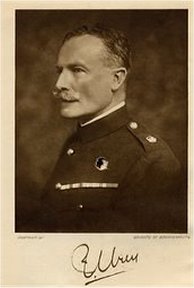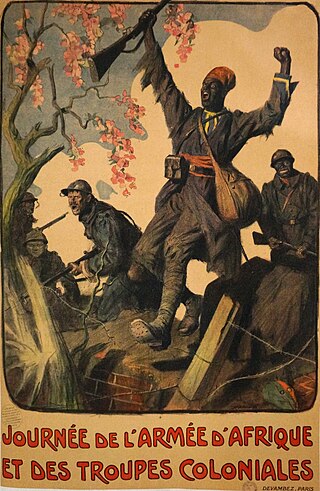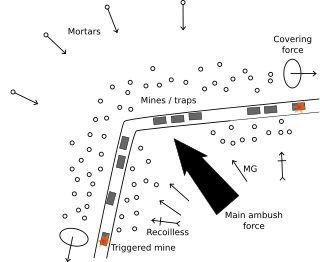
43.2925°N 5.5534°E

The Lebel Model 1886 rifle also known as the "Fusil Mle 1886 M93", after a bolt modification was added in 1893, is an 8 mm bolt-action infantry rifle that entered service in the French Army in 1887. It is a repeating rifle that can hold eight rounds in its fore-stock tube magazine, one round in the elevator plus one round in the chamber; equaling a total of ten rounds held. The Lebel rifle has the distinction of being the first military firearm to use smokeless powder ammunition. The new propellant powder, "Poudre B," was nitrocellulose-based and had been invented in 1884 by French chemist Paul Vieille. Lieutenant Colonel Nicolas Lebel contributed a flat nosed 8 mm full metal jacket bullet. Twelve years later, in 1898, a solid brass pointed (spitzer) and boat-tail bullet called "Balle D" was retained for all 8mm Lebel ammunition. Each case was protected against accidental percussion inside the tube magazine by a primer cover and by a circular groove around the primer cup which caught the tip of the following pointed bullet. Featuring an oversized bolt with front locking lugs and a massive receiver, the Lebel rifle was a durable design capable of long range performance. In spite of early obsolete features, such as its tube magazine and the shape of 8mm Lebel rimmed ammunition, the Lebel rifle remained the basic weapon of French infantry during World War I (1914–1918). Altogether, 3.45 million Lebel rifles were produced by the three French state factories between 1887 and 1916.

Percival Christopher Wren was an English writer, mostly of adventure fiction. He is remembered best for Beau Geste, a much-filmed book of 1924, involving the French Foreign Legion in North Africa. This was one of 33 novels and short story collections that he wrote, mostly dealing with colonial soldiering in Africa.

The Fusil-mitrailleur Modèle 1924 M29, designed in 1924 by the Manufacture d'Armes de Châtellerault, was the standard light machine gun of the French Army from 1925 until the 1960s and was in use until 2000-2006 with the National Gendarmerie. A robust and reliable weapon, it equipped the French army for much of the twentieth century and had the reputation of being a trustworthy and quality weapon.

Operation Castor was a French airborne operation in the First Indochina War. The operation established a fortified airhead in Điện Biên Province, in the north-west corner of Vietnam and was commanded by Brigadier General Jean Gilles. The Operation began at 10:35 on 20 November 1953, with reinforcements dropped over the following two days. With all its objectives achieved, the operation ended on 22 November. Castor was the largest airborne operation since World War II.

The Army of Africa was an unofficial but commonly used term for those portions of the French Army stationed in French North Africa from 1830 until the end of the Algerian War in 1962, including the French units made up of indigenous recruits.
Jules Gaucher was a French Army officer noted for his command of Foreign Legion troops in Indochina. Described as a "burly, hard-drinking veteran of years of jungle fighting, with a nose like an axe-blade and a mouth like its cut", Gaucher was a popular commander among the Legion, known as 'the Old Man' to his troops. He was killed at the Battle of Dien Bien Phu in 1954.

The lizard pattern is a family of many related designs of military camouflage pattern, first used by the French Army on uniforms from 1947 to the late 1980s. It was based on the British paratroopers' Denison smock. The use of the pattern is widespread in Africa, despite its association with France, because armed factions and militaries tend to obtain them from whichever source has it available.

Operation Mouette was an operation in 1953 by the French Army in Northern Vietnam during the First Indochina War. It was launched on October 15 in an attempt to locate and destroy Viet-Minh Chu Luc troops operating under the command of Võ Nguyên Giáp around the area of Phu Nho Quan, south of the Red River Delta. Following the establishment of a French camp in the area, various troops were dispatched to engage the Viet-Minh forces. The operation was ended and the French withdrew by November 7, claiming approximately 1,000 enemy combatants killed, twice as many wounded, and 181 captured as well as a substantial quantity of weapons and ammunition.

Operation Brochet took place during the French Indochina War, between August and October, 1953. A combined arms operation, Brochet involved 18 battalions of the French Expeditionary and Vietnamese National Armies fighting against the 42nd and 50th Viet Minh Regiments, fighting in the southern reaches of the Red River Delta near Tonkin in North Vietnam. The 1st and 2nd Parachute Battalions of the French Foreign Legion (BEP), and the 1st and 3rd Colonial Parachute Battalions (BPC) took part, as did forces of the Vietnamese National Army. Their objective was to sweep the Delta and remove Viet Minh influence.

The Battle of Cao Bằng was an ongoing campaign in northern Indochina during the First Indochina War, between the French Far East Expeditionary Corps and the Việt Minh, which began in October 1947 and culminated on September 3, 1949. Since the start of the conflict, Việt Minh troops had ambushed French convoys along the Vietnam–China border from the Gulf of Tonkin on a 147-mile route to a French garrison at Cao Bằng, known as Route Colonial 4, or RC4. Repeated ambushes led to repeated French operations of increasing strength to reopen the road, including a costly mission by the Foreign Legion in February 1948. On July 25, 1948, the Cao Bằng encampment was itself attacked and held out for three days with two companies defending against two battalions of Việt Minh. A further 28 ambushes took place in 1948.

The 4th Foreign Regiment is a training regiment of the Foreign Legion in the French Army. Prior to assuming the main responsibility of training Legion recruits, it was an infantry unit which participated in campaigns in Morocco, Levant, French Indochina, and Algeria.

The 2nd Foreign Cavalry Regiment was a cavalry regiment of the Foreign Legion in the French Army. the regiment was dissolved twice in 1946 and 1962; the regimental colors have been entrusted by the Foreign Legion Detachment in Mayotte since 1984.

The 6th Foreign Infantry Regiment was an infantry regiment of the Foreign Legion in the French Army from 1939 to 1941 and again from 1949 to 1955.

The Republic of Vietnam Military Forces, were the official armed defense forces of the defunct Republic of Vietnam and was responsible for the defense of the state since its independence from France in October 1955 to its demise in April 1975.
General Jean Baptiste Philippe Théveney was a French army officer. His father was a cavalry officer and Théveney was educated at the Ecole Spéciale Militaire de Infanterie before being commissioned as an infantry officer. He served in a number of staff and regimental appointments in France before joining the 1st Foreign Regiment of the French Foreign Legion and seeing active service in Algeria. Théveney followed the regiment to Morocco where it was involved in the Zaian War against the Berbers.
Colonel Joseph Dérigoin was a French army officer. He served as a lieutenant with the French Foreign Legion in the occupation of Madagascar, distinguishing himself in an attack on a Malagasy fortification. He later rose to command a French column during the Zaian War in Morocco and served as a colonel in the First World War.
General Antoine Jules Joseph Huré was a French army officer and engineer noted for his service in Morocco. Huré joined the army as a volunteer in 1893 and after training at the École Polytechnique and École d'Application de l'Artillerie et du Génie he was commissioned into the 3rd Regiment of Engineers. He spent a number of years with his regiment and on staff appointments in France before transferring to Algeria first with the 19th Army Corps, and then the 15th Army Corps. In 1912 Huré transferred to the general staff in eastern Morocco and earned the Colonial Medal.
Sidi Mhand n'Ifrutant was a Moroccan military leader active during the Zaian War.

The Battle of Rashaya was a four-day battle fought at the citadel of Rashaya on 20 – 24 November 1925 between Druze rebels and the French Army of the Levant during the Great Syrian Revolt against French Mandatory rule.














